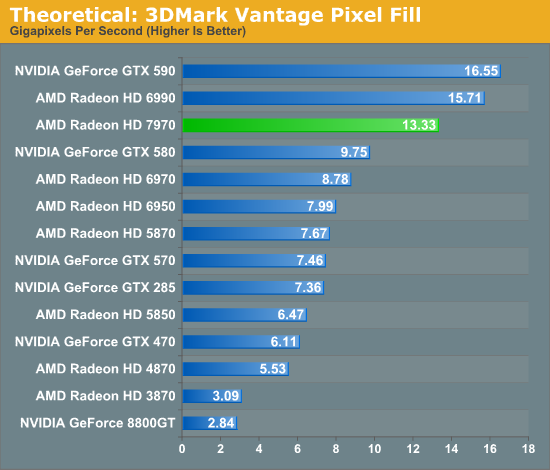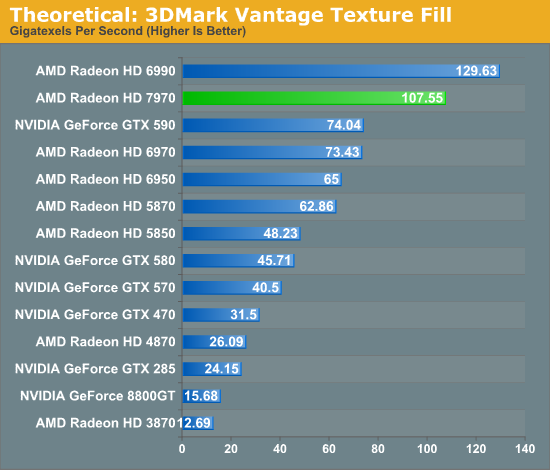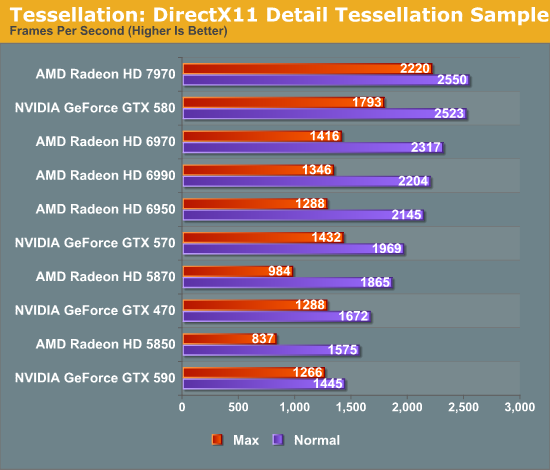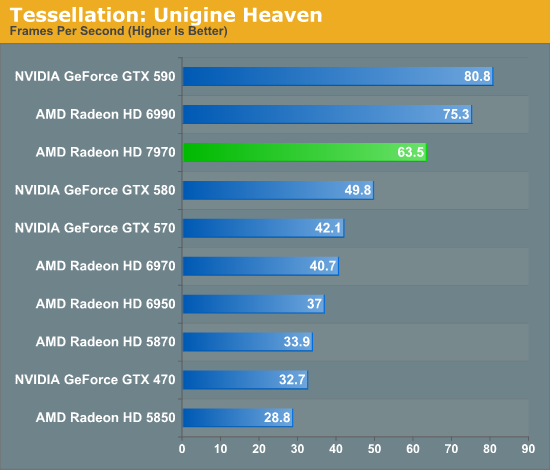AMD Radeon HD 7970 Review: 28nm And Graphics Core Next, Together As One
by Ryan Smith on December 22, 2011 12:00 AM EST- Posted in
- GPUs
- AMD
- Radeon
- ATI
- Radeon HD 7000
Theoreticals & Tessellation
From a rendering perspective one of the most interesting things AMD did with Tahiti was what they didn’t do: they didn’t add more ROPs, they didn’t add more geometry engines. And yet based on our game performance they’ve clearly improved on their performance in those situations by making more efficient use of the hardware they do have.
So we wanted to take a quick look at synthetic performance to see what these tools had to say about AMD’s changes. We’ve included the numbers for every other GPU in our lineup as a reference point, but we would strongly suggest against reading into them too much. AMD versus AMD is sometimes relevant to real world performance; AMD versus NVIDIA rarely is.

We’ll start with 3DMark Vantage and its color fill test. This is basically a ROP test that attempts to have a GPU’s ROPs blend as many pixels as it can. Theoretically AMD can do 32 color operations per clock on Tahiti, which at 925MHz for 7970 means the theoretical limit is 29.6Gpix/sec; not that any architecture is ever that efficient. In practice 7970 hits 13.33Gpix/sec, which is still well short of the theoretical maximum, but pay close attention to 7970’s performance relative to 6970. Even with the same number of ROPs and a similar theoretical performance limit (29.6 vs 28.16), 7970 is pushing 51% more pixels than 6970 is.
In designing Tahiti AMD said that they didn’t need more ROPs they just needed more efficient ROPs, and it looks like they’ve delivered on this. It’s not clear whether this is the limit for efficiency or if AMD can squeeze more out of their ROPs in future designs, but this definitely helps to prove that there’s more to graphics rendering than a large number of functional units.

Our other 3DMark synthetic benchmark is the 3DMark Vantage Texture Blend test, which measures how quickly a GPU can blend multiple FP16 textures. This is more synthetic than most tests because FP16 textures aren’t widely used, but it’s a consistent benchmark.
The theoretical performance improvement from 6970 to 7970 is 40% - 33% more texture units operating at a 5% higher clockspeed. In practice the 7970 exceeds that improvement by increasing texture performance by 46%, meaning the 7970 has benefitted from more than the increase in texture units. Most likely the new cache architecture has further improved the efficiency of the texture units, although the 3DMark texture set is not particularly large.
Moving on, we also wanted to take a look at tessellation. AMD did not increase the theoretical geometry performance of Tahiti as compared to Cayman – both top out at 2 triangles per clock – but AMD has put a lot of effort into improving the efficiency of Tahiti’s geometry units as we’ve seen reflected in our game benchmarks.

Our first tessellation benchmark is the traditional Detail Tessellation sample program from the DirectX SDK. Here we’re looking at tessellation performance as a product of the framerate, testing at tessellation factors 7 (normal) and 15 (max). Traditionally this is a test that has been rather balanced at normal tessellation levels, while NVIDIA cards with their superior geometry throughput have been the top performers at maximum tessellation levels. So it’s all the more interesting when we’ve seen the tables turned; the 7970 is merely competitive with the GTX 580 at normal tessellation levels, but now it’s ahead of the GTX 580 by 24%. More significantly however the 7970 is ahead of the 6970 by 57%.

Our second tessellation benchmark is Unigine Heaven, a benchmark that straddles the line between a synthetic benchmark and a real-world benchmark, as the engine is licensed but no notable DX11 games have been produced using it yet. In any case the Heaven benchmark is notable for its heavy use of tessellation, which means it’s largely a proxy test for tessellation performance.
As with the Detail Tessellation sample program, Heaven shows significant gains for the 7970 versus the 6970, with the 7970 leading by 56%. Meanwhile it leads the GTX 580 by 27%, which is actually slightly better than what we saw under the more “pure” Detail Tessellation sample. Between these two benchmarks it’s clear that AMD’s tessellation efficiency improvements are quite real, and that with Tahiti AMD can deliver much better tessellation performance than Cayman even at virtually the same theoretical triangle throughput rate.
Of course one has to wonder what NVIDIA will have in store for Kepler next year. Their current Fermi design seems to scale well with additional geometry units, but if Tahiti is anything to go by, there’s a great deal to be gained just by focusing on efficiency. NVIDIA has prided themselves on their geometry performance since before GF100 even shipped, so it will be interesting if they have anything in store to hold on to that distinction.










292 Comments
View All Comments
chiddy - Thursday, December 22, 2011 - link
Ryan,Thanks for the great review. My only gripe - and I've been noticing this for a while - is the complete non-mention of drivers or driver releases for Linux/Unix and/or their problems.
For example, Catalyst drivers exhibit graphical corruption when using the latest version (Version 3) of Gnome Desktop Environment since its release before April. This is a major bug which required most users of AMD/ATI GPUs to either switch desktop environments, switch to Nvidia or Intel GPUs, or use the open source drivers which lack many features. A partial fix appeared in Catalyst 11.9 making Gnome3 usable but there are still elements of screen corruption on occassion. (Details in the "non-official" AMD run bugzilla http://ati.cchtml.com/show_bug.cgi?id=99 ).
AMD have numerous other issues with Linux Catalyst drivers including buggy openGL implementation, etc.
Essentially, as a hardware review, a quick once over with non-Microsoft OSs would help alot, especially for products which are marketed as supporting such platforms.
Regards,
kyuu - Thursday, December 22, 2011 - link
Why in the heck would they mention Linux drivers and their issues in an article covering the (paper) release and preliminary benchmarking of AMD's new graphics cards? It has nada to do with the subject at hand.Besides, hardly anyone cares, and those that do care already know.
chiddy - Thursday, December 22, 2011 - link
And I guess that AMD GPUs are sold as "Windows Only"?Thanks for your informative insight.
MrSpadge - Thursday, December 22, 2011 - link
There are no games for *nix and everything always depends on your distribution. The problems are so diverse and numerous.. it would take an entire article to briefly touch this field.Exagerating, but I really wouldn't be interested in endless *nix troubleshooting. Hell, I can't even get nVidia 2D acceleration in CentOS..
chiddy - Thursday, December 22, 2011 - link
You have a valid point on that front and I agree, nor would I expect such an article any time soon.However, on the other hand, one would at the very least expect a GPU using manufacturer released drivers to load a usable desktop. This is an issue that was distro agnostic and instantly noticeable, and only affected AMD hardware, as do most *nix GPU driver issues!
If all that was done during a new GPU review was fire it up in any *nix distribution of choice for just a few minutes (even Ubuntu as I think its the most popular at the moment) to ensure that the basics work it would still be a great help.
I will have to accept though that there is precious little interest!
Ryan Smith - Thursday, December 22, 2011 - link
Hi Chiddy;It's a fair request, so I'll give you a fair answer.
The fact of the matter is that Linux drivers are not a top priority for either NVIDIA or AMD. Neither party makes Linux drivers available for our launch reviews, so I wouldn't be able to test new cards at launch. Not to speak for either company, but how many users are shelling out $550 to run Linux? Cards like the 7970 have a very specifically defined role: Windows gaming video card, and their actions reflect this.
At best we'd be able to look at these issues at some point after the launch when AMD or NVIDIA have added support for the new product to their respective Linux drivers. But that far after the product's launch and for such a small category of users (there just aren't many desktop Linux users these days), I'm not sure it would be worth the effort on our part.
chiddy - Friday, December 23, 2011 - link
Hi Ryan,Thanks very much for taking the time to respond. I fully appreciate your position, particularly as the posts above very much corroborate the lack of interest!
Thanks again for the response, I very much appreciate the hard work yourself and the rest of the AT team are doing, and its quality speaks for itself in the steady increase in readers over the years.
If you do however ever find the time to do a brief piece on *nix GPU support after launch of the next generation nVidia and AMD GPUs that would be wonderful - and even though one would definately not buy a top level GPU for *nix, it would very much help those of us who are dual booting (in my case Windows for gaming / Scientific Linux for work), and somewhat remove the guessing game during purchase time. If not though I fully understand :-).
Regards,
Ali
CeriseCogburn - Thursday, March 8, 2012 - link
Nvidia consistenly wins over and over again in this area, so it's "of no interest", like PhysX...AmdInside - Thursday, December 22, 2011 - link
I won't be getting much sleep tonight since that article took a long time to read (can't imagine how long it must have taken to write up). Great article as usual. While it has some very nice features, all in all, it doesn't make me regret my purchase of a Geforce GTX 580 a couple of months ago. Especially since I mainly picked it up for Battlefield 3.ET - Thursday, December 22, 2011 - link
The Cayman GPU's got quite a performance boost from drivers over time, gaining on NVIDIA's GPU since their launce. The difference in architecture between the 79x0 and 69x0 is higher than the 69x0 and 58x0, so I'm sure there's quite a bit of room for performance improvement in games.Have to say though that I really hope AMD stops increasing the card size each generation.